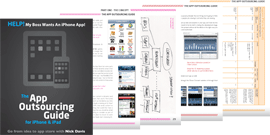This guide is designed to take you through the entire process of outsourcing an iPhone / iPad app from start to finish.To help with this, the guide is split into five, chronological parts which you can use as an easy reference as you work your way through your project:
- The Concept – getting all your ideas straight and writing a clear plan
- The Supplier – finding the best supplier for what you need
- The Project – dealing with the project itself and keep everything on track
- The Push – ideas and suggestions for marketing your app
- The Launch – pressing ‘GO’ (and what happens afterwards)
Although you can just read the guide as your project unfolds, I would recommend reading the entire document through once first if you can. This will give you an idea of what to expect, as no two app projects will follow exactly the same process.
Also provided are some document templates in the Resources section at the end of this guide which are designed to help you deal with some of the common processes you are likely to face during your project. Using these templates is entirely optional but they should give you a framework for structuring the project if you’re not sure where to start.All of these can be also be downloaded in .doc and .xls format in the Members Area (under Resources) of the companion website to this guide app-outsourcing-guide.com
In the guide itself I have tried wherever possible to take you through every process step-by-step. Please bear in mind though that in the fast changing online and app worlds some of these processes will change over time. My way is not the only way of getting an app in the App Store by outsourcing, and I am hopeful that you will find yourselves adding or tweaking some of the processes and templates I have provided to your own needs as you grow in confidence.
Some things the guide will help you with:
- Taking all the ideas surrounding your app, organising them and – with as little stress as possible – turning them into a easy to follow specification that will help you get any signoff you need and give you a great starting point for talking to developers.
- Exploring free, paid, ‘lite’ and ‘full’ app strategies and figuring out which ones are right for you.
- Dealing with the Apple guidelines, registration and submission processes and staying sane.
- Getting dozens of useful quotes from different suppliers and being able to pick between them.
- Managing the project and staying up-to-date with progress throughout.
- Conducting a thorough testing process so that even complex apps, with many dependencies, are accepted first time by Apple.
- Finding statistics and analytical tools that will help you measure the success of your app.
- Marketing your app so that is has the best chance of success (without breaking the bank either).
- Getting your app in the App Store!
What the guide isn’t:
- Supported or endorsed by Apple in any way (and neither do any of the other apps or other companies mentioned).
- A ‘how to code’ apps guide. I focus purely on the process of outsourcing your app (though if you are interested in coding or creating apps yourself there are a couple of pointers too).
- A guarantee of a successful submission to Apple or the #1 slot on the App Store (as much as we’d like you to achieve that!).
- I hope the next 148 pages give you everything you’re looking for. Good luck with your app project.
